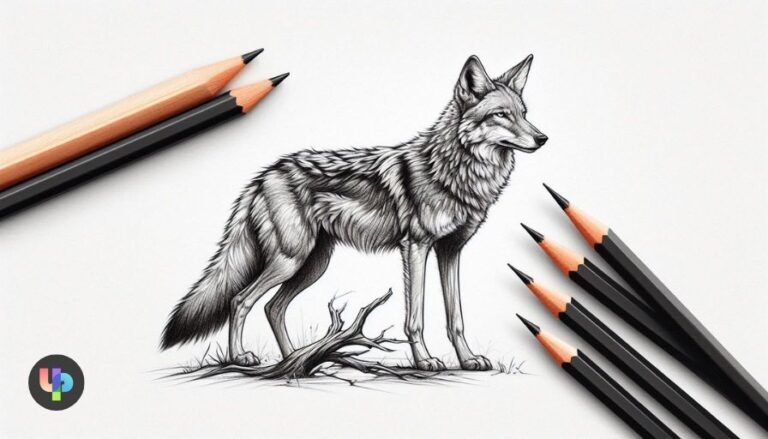Coyotes are fascinating animals that have captured the attention of artists for generations. Their mysterious nature, cunning behavior, and distinctive physical traits make them a popular subject for artistic expression. DrawingWny4zn3jqnm= Coyote explores various techniques, tools, and cultural perspectives that enhance an artist’s ability to bring this wild creature to life on paper.
Understanding Coyote Anatomy
A fundamental step in creating an accurate and lifelike drawing of a coyote is understanding its anatomy. Coyotes possess a slender, agile body with strong legs and a flexible spine that allows them to move swiftly. When drawing, it’s essential to focus on these core features, especially the coyote’s pointed ears, narrow snout, and bushy tail. By studying the skeletal structure, you can better depict the animal’s fluidity and strength in your artwork.
- Key Anatomical Features:
- Head: Narrow with a prominent snout and large, pointed ears.
- Body: Long and sleek, built for speed and agility.
- Tail: Thick and bushy, often drawn in a relaxed curve.
Mastering Fur Textures
One of the more challenging aspects of drawing a coyote is capturing the texture of its fur. Coyotes have thick, coarse fur with subtle color gradations that add depth and realism to your drawing. Artists often employ a variety of shading techniques, including cross-hatching and stippling, to mimic the different textures of the fur.
To create a more dynamic piece, focus on the direction in which the fur flows, especially around the neck and tail. Paying attention to the gradation in fur tones can significantly enhance the realism of the drawing.
Shading Techniques for Depth
Shading plays an essential role in giving your drawing depth and form. By understanding light sources and shadows, you can create a three-dimensional appearance. For a coyote drawing, focus on areas such as the limbs, torso, and snout to capture the natural shadows cast by the animal’s body. Use softer pencils like 4B or 6B to build up darker areas and harder pencils (like 2H) for lighter sections.
Basic Shading Tips:
- Identify the light source to determine where shadows will fall.
- Use a variety of pencil hardness to create depth and contrast.
- Blend with a paper stump to smooth transitions and create softer tones.
Exploring Coyote Symbolism in Art
Coyotes are not only intriguing for their physical attributes but also for their rich cultural symbolism. In Native American folklore, the coyote often appears as a trickster figure, embodying adaptability, intelligence, and unpredictability. Artists may choose to reflect these traits in their work by incorporating elements of the coyote’s symbolic nature. This adds another layer of depth to the artwork, inviting viewers to explore the coyote’s role in culture and mythology.
For example, many artists capture the coyote in playful or contemplative poses, reflecting the duality of its nature as both a mischievous trickster and a wise figure.
Step-by-Step Guide: Drawing a Realistic Coyote
1. Start with Basic Shapes:
Begin your drawing with basic shapes to outline the coyote’s form. Use a circle for the head, an elongated oval for the body, and lines to mark the placement of the legs and tail. This framework will help guide the proportions as you refine the drawing.
2. Define the Head and Face:
Refine the shape of the head by adding the snout and large ears. Be sure to place the eyes in line with the snout for an accurate representation. Pay special attention to the coyote’s eyes, as they are key to capturing its alert, intelligent expression.
3. Outline the Body and Legs:
Gradually define the body and limbs, focusing on the sleek, athletic build of the coyote. Coyotes have long, slender legs that are designed for running, so make sure the legs are proportional to the body.
4. Add Fur Texture and Detail:
Once the basic outline is complete, begin adding texture to the drawing by sketching short, controlled lines to represent the fur. Focus on areas like the neck and tail, where the fur is thickest. Be mindful of the direction in which the fur flows across the body.
5. Incorporate Shading for Realism:
Use a combination of shading techniques to add depth and contrast. Start by identifying your light source and shade accordingly, making sure to keep the highlights and shadows consistent throughout the drawing.
6. Finalize and Refine the Drawing:
Once you’ve completed the shading, take time to review your work. Make any necessary adjustments to the proportions and refine the details to ensure accuracy. Erase any construction lines and add a signature to your artwork.
Conclusion
Mastering DrawingWny4zn3jqnm= Coyote requires a combination of understanding anatomy, fur textures, and shading techniques. With practice, you can create lifelike representations that capture the essence of the coyote’s wild spirit. Whether you’re a beginner or an experienced artist, this subject offers endless opportunities to explore creativity while developing your skills.
